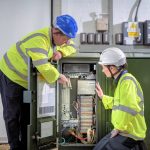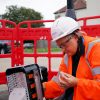Openreach Stops Selling New UK Analogue Copper Phone Lines

Openreach (BT) has this morning confirmed that they’ve formally introduced their long-planned UK wide “stop sell” on sales of new Wholesale Line Rental (WLR) and related broadband ISP products, which is part of their aim to completely withdraw the old copper-based Public Switched Telephone Network (PSTN) by December 2025.
As we’ve said before, this does NOT impact existing customers of these products (until the 2025 deadline), unless you switch provider/package as the old service types will no longer be available. So anybody looking to buy a traditional analogue copper phone line rental (WLR and SMPF) service from a provider – including any linked broadband services (e.g. FTTC, G.fast, ADSL) – will no longer be able to do so and must instead take an IP-based alternative (more on that later).
However, the exception to this rule is fully unbundled (MPF) lines, such as those sold by various ISPs like TalkTalk and Sky Broadband that have invested to gain more control over BT / OR’s lines – enabling them to sell cheaper and more flexible copper-based broadband and phone products.
Advertisement
Fully unbundled ISPs will technically be able to continue selling the older products to new customers, but that won’t last forever, and eventually (post 2030) even the old exchanges will be retired. But we should point out that most of those providers have also already introduced IP based phone / Digital Voice style alternative products of their own too.
Nevertheless, the stop sell move is currently most relevant to ISPs and phone providers with a large base of regular (WLR and SMPF) phone and broadband lines, such as BT, Zen Internet and many others. But the vast majority of those providers have already introduced alternative copper-based broadband products that don’t need to depend on the old PSTN/WLR system.
James Lilley, Openreach’s Director of Managed Customer Migrations, said:
“As long as anyone can remember, the vast majority of phone calls in the UK have been handled by BT’s public switched telephone network (PSTN) – an analogue system which connects people using specific phone numbers.
But over time, the PSTN’s become outdated and difficult to maintain. Skills and parts are increasingly difficult to come by and new digital services like Voice over IP (VoIP), video conferencing and a whole range of apps have become more popular and effective for people communicating with one another.
Back in 2017, BT saw this coming – signalling their intention to retire the PSTN network by the end of 2025 – and ever since then, we’ve been working to withdraw any Openreach products that work over the PSTN, including Wholesale Line Rental (WLR).
WLR is used by a number of our Communications Provider (CP) customers, and we’ve been working closely with them for years to help them prepare for the change.
As part of that process, we’re now taking the significant step of ending the sale of WLR across the UK. That means from today, when CPs’ customers sign up to a new contract – or when they switch, upgrade or re-grade their service via their provider – they’ll be moved onto a new digital line rather than an analogue one.
We’ll continue to do everything we can, working closely with our CP customers, to upgrade vulnerable customers and those customers using Critical National Infrastructure as safely and smoothly as possible and we have the processes in place to ensure this happens.
Ideally the new service will be delivered over our brand new Full Fibre network – which is already available to 11m homes and businesses nationwide – but, where that’s not available, we’ll move them onto a digital alternative.
We’ve already made lots of progress getting customers to ‘go digital’. Since 2020 we have gradually stopped selling copper services in exchanges where we have built full fibre. This covers more than 500 of our exchange areas – covering some 4.6m premises, so far and will continue at pace.
We’re determined to deliver a world-class, modern and reliable communications service for the entire UK and today is another important step towards the UK’s digital transformation.”
As above, Openreach’s ultimate goal is to get everybody moved on to their gigabit-capable Fibre-to-the-Premises (FTTP) lines, but not everybody is covered by that yet. Consumers in those areas will thus still be able to take broadband via special versions of the ADSL (SOTAP), FTTC (SOGEA) and G.fast (SOGFast) products – these are essentially standalone copper-based broadband lines, albeit with no analogue phone service attached.
The key difference above is that anybody in a WLR/PSTN “stop sell” area who orders or upgrades to one of those new broadband-only (SOTAP, SOGEA, SOGFast) lines may not get a phone service included by default (i.e. this becomes an optional add-on). Customers who want to retain a home phone service will thus need to ensure that their ISP has launched a digital (IP / VoIP – based) phone solution (e.g. BT’s Digital Voice product).
Advertisement
Digital phone services are a bit different from the old analogue service and often involve customers needing to plug their existing phone handsets into the back of a broadband router (assuming it has an FSO/FXO phone port) or Analogue Terminal Adapter (ATA) device (these plug into the LAN port on your router), rather than the old Master Socket (e.g. NTE5A, NTE5C) on your wall.
Some providers, such as BT, have already run into problems with their Digital Voice service (here), which highlights some of the caveats with the new approach and its extra complexity (e.g. the need for battery backup during power outages) and thus why it’s so important for consumer-facing ISPs to have the right solutions in place to ensure a smooth migration. Vulnerable users (e.g. pensioners) should also make their provider away of that status as they may be able to get extra support.
However, many providers have long since already begun shifting customers on to the replacement products. But it’s fair to say that the biggest stumbling block is likely to be in third-party products and services (e.g. alarms and telecare services), many of which haven’t yet fully adapted to this change.
Mark is a professional technology writer, IT consultant and computer engineer from Dorset (England), he also founded ISPreview in 1999 and enjoys analysing the latest telecoms and broadband developments. Find me on X (Twitter), Mastodon, Facebook, BlueSky, Threads.net and Linkedin.
« Common Wholesale Platform Makes Progress on One Touch Switch























































This is (inevitably) going to be messy.
PSTN is yesterday’s technology, but it was a very mature technology, and in its final incarnation (at least in this country) offered a very reliable and resilient service.
The replacements and alternatives are some way off offering the same levels of reliability and resilience – for one example see yesterday’s widespread problem (Mon 4 Sept) of Vodafone mobile customers being unable to call EE mobile numbers (an apparent fault at EE’s end).
Voda not being able to call EE appears to be some breakage on ported number routing; which if it had happened to landline number ranges would have likely equally impacted call routing for analogue and digital voice landlines.
hell of a stretch to suggest that the PSTN never had issues with call routing between certain network operators.
SIP and related protocols are themselves fairly mature, and until/unless the reason for the fault is disclosed (unlikely, unless Ofcom takes an interest) we won’t know if it’s the technology or someone pushed the wrong button
You can have the same problems with POSTN. The data to data shows service reliability with Digital lines is better than for analogue lines
@plunet
It’s not an ‘if’ – issues with ported landlines happens, and not rarely. I probably have a couple tickets a month of such fiascos in some form.
There are going to be so many people that wont move off of this until they have no other option .
Why should they want to remain on an old copper line? I think it is likely that Digital will become cheaper than an analogue line which will help move people to Digital
@Bob, maybe people still want their working if they have a power cut, I realise that a lot of people have dect phones these days, but some don’t. Also what about people who have equipment that don’t work over this digital voice thing?
DECT phones shouldn’t be a barrier; BT routers at least provide a traditional phone socket. You can use both at once – we have four phones, two of which are a traditional wireless set.
Anything relying on power from the phone line will require a separate solution, and backup is likewise an issue – I power it via a UPS that is also used for the server relying on the net.
Don’t forget DECT is a standard meaning that any complient DECT handset should pair with any DECT base station. I have managed to pair Gigaset handsets with the base station in BT’s smart hub 2 so you don’t have to necessarily buy BT advanced digital handsets.
I think Ad47uk’s point with DECT phones is if you have a powerful they stop working as they usually need power for the base station to work.
I’m sure this is a stupid question but how well do voip services work over very flaky, low bandwidth ADSL lines?. Until not so long ago I was on 3Mbps ADSL and some of my neighbours are still stuck with ~2Mbps ADSL with no other viable options.
My experience was that it was so easy to saturate the bandwidth that trying to run anything like realtime like VoIP was unreliable at best.
At the time my analogue phone line was unaffacted (although every time I got an incoming call the ADSL was disconnected).
How well does a voice-only Whatsapp or Skype call work? That will give you a rough idea.
Under the terms of the broadband USO, you have the right to *request* a 10Mbps connection from BT (or KCOM if you’re in Hull).
There’s no guarantee that you’ll actually get one – not without a large bill anyway – but it’s worth requesting. You might at least be provided with a 4G/5G terminal with external antenna, which performs better than your current copper ADSL connection.
In a very small number of cases, you could even get FTTP. They are able to take into account expected demand from adjacent properties, and there is a set amount BT are required to contribute to each one (around £3,000 I think)
An upload or download speed of less than 100Kbps (that’s 0.1Mbps) should be enough for at least a single good quality call, although some services can work with just 30Kbps. In short, don’t worry about your speeds.
it’ll work fine if it’s engineered properly, for example if it’s an ISP provided VoIP service where they can control the quality of service to ensure it gets priority over other traffic.
If you were using a third party VoIP service then of course it’s going to degrade if you use the connection for other purposes, at least in the downstream direction where you have no control over what gets sent.
Openreach have come out with a 0.5Mbps VDSL/FTTP product for the “landline only” replacement scenario. Again, should work fine for properly designed services.
I had vonage for a business landline from about 2006 until 2016 and it was on 2MB ADSL from around 2006 to 2009 and was as clear as a bell. I had no issues with it, so that will give you an idea
BT did lots of tests a few years back at Adastral Park and showed that the average slow ADSL line like those mentioned here would not work well for Digital voice. I’m not sure if they’ve improved codecs, but there are some basics both BT and the people reporting are ignoring.
Slow ADSL lines are either very long or a mix of copper and aluminium, these lines generally have issues with frequent resyncs, packet loss and errored seconds. QoS can help ensure the little bandwidth there is assigned, but it cannot help with the above.
How does an emergency call work when the line resyncs or gets packet loss? It doesn’t and BT and others will fail to meet Ofcom requirements for emergency calls. The only fix here is having 4G backup or sorting the lines to something better.
Openreach have passed this problem to BT and other ISPs and the press think it is not an issue. There is a reason SoTAP has been talked about for over 5 years yet is only just about launched.
Aren’t there a lot of variables in play though? A hypothetical ADSL line used solely for VoIP could be limited down to a much slower speed than it would have been in rate adaptive mode, you can crank up the interleaving and error protection, etc. BT never used seamless rate adaptation themselves but others did.
At what point does the goal become “does it work well enough” and not “does it achieve a 4.4 MOS 100% of the time”, especially since the number of users who can’t even get the 0.5Mbps VDSL service is likely to be vanishingly small. BT (Group) clearly thinks they’ve got the bases covered, hence the stop sell now in effect.
The old lines used 64Kbps, and that with a codec from the 80s. ISDN30 which supported 30 concurrent calls was 2Mbps.
In terms of making a call over the internet other issues will probably matter more than bandwidth. The main ones being packet loss and latency. Given digital voice and similar are hosted by the ISP they should suffer less than say teams/Skype/whatsapp
GSM worked at around 13Kbps plus another 3Kbps for signalling. So 16Kbps was ample to provide a decent call quality. We’ve come a long way since then too.
Not a stupid question. There is a 500k broadband FTTP product for exactly this reason – VOIP needs very little bandwidth and will work just fine on considerably less than 500k
As many other comments speed is not really be the issue, provided that the bandwidth is protected from other general broadband use, which it usually is if it’s an ISP provisioned Digital Voice product, but not if it’s a separate over-the-top VoIP service.
But jitter (the variance over time of latency) will cause problems with VoIP, so actually it’s more likely to be cranky and poor quality broadband rather than slow broadband that will be a showstopper for VoIP.
Even non native isp voip is marked with a priority
I know a few premises in Devon where even ADSL isn’t available due to the line length (its over 20 km), analogue voice is the only service available, I wonder how these will be dealt with?
@Jan
Priority marking is ignored. It’s public IP, not MPLS.
So how does this impact home care alarms for the disabled etc. They still seem to need a phone line? Or will they be limited to only unbundled ISP providers?
To me this seems to be getting shoved out at speed, and they know full well it will leave vulnerable people behind. If they want to move they may find their alarm system will not work, and it will be a real hassle trying to find a solution.
I think the government should be stepping in on this, but that’s a laugh to expect their help.
BT has been telling people about this for the best part of a decade. They even have a lab where telecare devices can be tested against the new network. Other ISPs don’t seem to have bothered with that.
They’ve taken about as much care and attention as you want, certainly not “shoved out at speed”, and it is also up to the telecare providers to do their bit and notify customers of what they need to do.
@Ivor – That’s the problem here. It requires Telecare providers to actually do something (And invest). Working in software I can tell you it damn near impossible to get people to get and stay on top of anything they are not forced too (IE compatibility anyone?). Why would a telecare provider invest £100,000s in developing new kit when they can continue to reap nice profits selling the stuff developed 20 years ago? I don’t support BT often but they are right here.
I have one of these care line devices on my PSTN line. I raised the issue of migration of equipment before the pandemic but have heard nothing from the provider (the Borough Council), the equipment supplier or Openreach. I think the equipment has a calling channel in a filtered sideband (e.g. 2700 to 3300Hz) on the analogue line. So I guess new equipment is required.
I suppose the fragmentation of the UK PSTN network was inevitable but the recent inter-network failure shows that the whole thing has become too complicated for mere humans to administer. There will always be failures of some kind and the need for alternatives (to Openreach provided ‘lines’) should be available to provide resilience. Not great for rural users who have difficulty getting USO speed and/or Mobile signal in the first place.
Most of the country will have good mobile coverage when PSTN is switched off, why not just use a mobile solution for all of these things? I live on a gated development, delivery drivers press the house number, and the system rings the associated household pre programmed telephone numbers to alert and converse with them; The access to our development isn’t over a landline, it uses SIM only contract via mobile.
It wouldn’t be difficult to produce a battery backed black box solution, using Broadband when available and mobile access should the broadband go down. I don’t see any difficulty finding solutions to the PSTN switch off, it’s just a matter of the cost of replacing the current equipment.
Openreach announced this 6 years ago so alarm care providers have had more than enough time to sort this out, so if they haven that is negligent on their part, not Openreach.
I once had to deal with a complaint (and rightly justified) one of my (now former agents) had sold someone a FTTP package in a stop area without doing the appropriate checks and it was not until after they had moved that they called to ask when their PSTN line would be re activated which of course was not going to be possible. The copper had already been partly removed.
Managed to give them a free lifetime digital voice service. But that is one such example of the above.
Oh forgot to add we also paid for them to have a chunky UPS installed to run the ONT for about 12 hours if the power went out. It was cheaper than the potential compensation etc and the lady was happy in the end.
A lot of city focussed thinking in some of the replies here. A few million of us live in rural areas away from towns or cities. You can have a mobile reception but usually only one provider gives good reliable coverage, and last I checked you cannot choose which provider a Careline company uses if they use cellular.
A careline provider should be using a multi-network SIM or at least checking network coverage in a location before sending their equipment out. This is very basic customer service stuff, and I don’t have any sympathy for these companies pretending like it’s BTs fault that they’ve done nothing for six years to prepare.
“Me” – I was born and raised in a rural area, one of the last to get ADSL back in the day actually. I had a couple of relatives in even more rural areas, one had a telecare alarm.
None of this changes my opinion in that this is not the big deal you are making it out to be.
They can still use the new fangled VoIP-derived landlines, they can connect directly to the internet over wifi/ethernet, and as others have said they could supply a SIM that does work in the area.
I remember when 999 went down… that was fun, the “backup” system failed too, thanks BT
My brother works in a 999 call centre. He said there is often 20+ waiting so I am sure no one really suffered.
We have Sky Broadband on FTTP with the incoming landline coming in via the router box. We hardly use the landline anymore but occasionally the hospital or doctors surgery will call the number. We kept it as Sky don’t charge extra for a landline number.
Does anyone know if, when we move house later this year, we can keep our landline number as it now comes in digitally via the box and we’re taking the box with us to the next house. I am in the Newcastle 0191 area code and we’re moving to Otterburn 01830. Sky were a bit evasive when I asked about this – we’d prefer to keep the old Newcastle number for those that still have it
Can’t speak with any great authority but I think your landline number will be tied to the serial number of your router so if you use your existing router at your new location it woillstill work, possibly?
From a technical standpoint area codes are largely irrelevant on VOIP so the only thing that tells you it’s a landline is it starts 01,02,03 in the same way 07 tells you it’s a mobile.
It’s probably possible. In the past you could only keep your number if you moved within the same exchange. With Sky being the exchange and with it being digital maybe? People can port from landline to VoIP and then change providers all the time once it’s “online”
It’s easily possible to keep a landline “geographic” number and be out of area. I took my landline number to A&A with their domestic VOIP offer, and that means if I want I can receive and make those calls anywhere in the world with an internet connection and a VOIP phone or ATA.
By taking the number to a true VOIP provider I’ve taken “ownership” of my landline number, rather than than leaving control with a mass market ISP, and I can easily do stuff like have it concurrently ring a mobile or other landline number. But since more than half of my incoming landline calls are criminals trying to defraud the vulnerable, I’ve not bothered with making it ring the mobile.
When I have had powercuts in the past that have lasted between 30 minutes to 6 hours or more the mobile phone networks have also gone down after about 15 minutes, with no signal on the mobile phone.
How will mobile backup in a powercut work if the phone masts don’t have any long lasting backup?
It won’t – no mast no service.
VoIP however can use kept up with a UPS.
Glad to see this went ahead as planned, as opposed to being delayed for reasons that were never going to be resolved simply by waiting a bit longer.
Time for the various care and security alarm providers to step it up a bit and tell their customers what their plans are.
Yes, even though there will inevitably be some lovers the PSTN exchanges are now 35-40 years old and obsolete and spare parts are becoming hard to source if they’re available at all. Add to this the amount of calls on the system has fallen so far due to mobiles, VOIP and various conferencing apps such as MS Teams it is completely financially unviable to replace it like for like. Also it is extremely power hungry and inefficient so it doesn’t have many green credentials either.
Germany went Digital in 1997 without any problems
ISDN lines were far more common in households in Germany, over here they were generally only in businesses or at the other end of Dial up ISPs.
Simple question – if I want just an analogue presented phone line, in the future, will I need to buy broadband too?
Yes, but you should take a step back and ask what you want the analogue presented phone line *for*, because there are a lot of better options if the answer is alarm signalling, remote equipment management etc.
Right now the withdrawl only applies to Openreach voice equipment, as such MPF (only Openreach copper, no active Openreach equipment) is not affected and analogue voice lines can be purchased from TalkTalk (and possibly Sky)
Long term Openreach are launching a 0.5mbps tier intended for voice only customers. This is technically a broadband connection but is very slow and cheap. Your ISP will provide a VOIP adapter.
It will still be possible to buy an analogue presenting phone line without signing up to a ‘broadband package’.
However, the way that will work will be via a broadband internet connection. Providers will be able to sell it in a way that is transparent to the end user, though taking into account some of the limitations listed in the article above.
Yes, but it may be better to buy a mobile to landline adapter unit (amazon sells these from around £50) and go for a cheap sim only deal if you’re in an area with good mobile service.
No. You’ll be provided with a very low speed data product solely for use with digital voice. It won’t have Internet access. You only need 100kbps for a high quality voice connection.
Does this mean that if you have a working existing cooper line phone and FTTC BB you can sit tight and ignore the hubbub until sometime after 2030?
Who is your ISP?
If it is BT/EE/Plusnet or an ISP that uses Openreach’s WLR product (if you call 17070 and it says Openreach, then this is the case) then your analogue phone service is going away by Dec 2025. Your ISP will have to either transfer to an IP based solution (in BT’s case, they call it Digital Voice) or discontinue phone services entirely.
If it is provided by another network (Sky, TalkTalk for example) then they can set their own timescale.
FTTC isn’t going anywhere, though there will be separate programmes to get people onto FTTP where it is available.
Total stupidity on the part of Openreach as they do not have the ability to install digital alternatives promptly. To restrict connections is sensible but to blanket rule them out is idiocy.